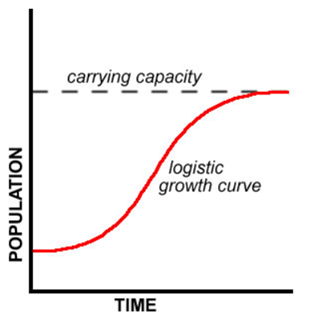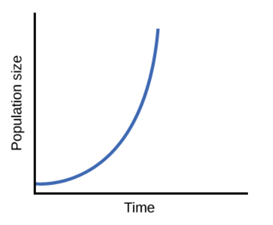
Concept explainers
a.
To show that
a.
Answer to Problem 36E
It is proved
Explanation of Solution
Given:
It is given that another differential equation that models limited growth of a population
Calculation:
The differential equation is
Using separation of variable method
integrating both side
where
Therefore, it is proved
b.
To find
b.
Answer to Problem 36E
The value of
Explanation of Solution
Given:
It is given that another differential equation that models limited growth of a population
Calculation:
Since,
c.
To find for what time
c.
Answer to Problem 36E
Population growth is fastest at
Explanation of Solution
Given:
It is given that another differential equation that models limited growth of a population
Calculation:
Since, the solution of differential equation
Now, by second derivative test
Therefore , population growth is fastest at
d.
To explain how does the growth curve in this model differ from the growth curve in the logistic model.
d.
Answer to Problem 36E
The graph of logistic curve has inflection point whereas the graph of limited growth does not have any inflection point.
Explanation of Solution
Given:
It is given that another differential equation that models limited growth of a population
The graph of logistic curve looks like the graph below

The graph of limited growth curve looks like the graph below

The graph of logistic curve has inflection point whereas the graph of limited growth does not have any inflection point.
Chapter 7 Solutions
Calculus 2012 Student Edition (by Finney/Demana/Waits/Kennedy)
Additional Math Textbook Solutions
Thomas' Calculus: Early Transcendentals (14th Edition)
Calculus: Early Transcendentals (2nd Edition)
Calculus: Early Transcendentals (3rd Edition)
Precalculus: Concepts Through Functions, A Unit Circle Approach to Trigonometry (4th Edition)
University Calculus: Early Transcendentals (4th Edition)
Precalculus Enhanced with Graphing Utilities (7th Edition)
 Calculus: Early TranscendentalsCalculusISBN:9781285741550Author:James StewartPublisher:Cengage Learning
Calculus: Early TranscendentalsCalculusISBN:9781285741550Author:James StewartPublisher:Cengage Learning Thomas' Calculus (14th Edition)CalculusISBN:9780134438986Author:Joel R. Hass, Christopher E. Heil, Maurice D. WeirPublisher:PEARSON
Thomas' Calculus (14th Edition)CalculusISBN:9780134438986Author:Joel R. Hass, Christopher E. Heil, Maurice D. WeirPublisher:PEARSON Calculus: Early Transcendentals (3rd Edition)CalculusISBN:9780134763644Author:William L. Briggs, Lyle Cochran, Bernard Gillett, Eric SchulzPublisher:PEARSON
Calculus: Early Transcendentals (3rd Edition)CalculusISBN:9780134763644Author:William L. Briggs, Lyle Cochran, Bernard Gillett, Eric SchulzPublisher:PEARSON Calculus: Early TranscendentalsCalculusISBN:9781319050740Author:Jon Rogawski, Colin Adams, Robert FranzosaPublisher:W. H. Freeman
Calculus: Early TranscendentalsCalculusISBN:9781319050740Author:Jon Rogawski, Colin Adams, Robert FranzosaPublisher:W. H. Freeman
 Calculus: Early Transcendental FunctionsCalculusISBN:9781337552516Author:Ron Larson, Bruce H. EdwardsPublisher:Cengage Learning
Calculus: Early Transcendental FunctionsCalculusISBN:9781337552516Author:Ron Larson, Bruce H. EdwardsPublisher:Cengage Learning





